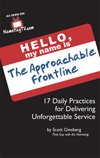 Since I started my publishing company eight years ago, I’ve had the honor and privilege of working with some of the finest organizations around the world:
Since I started my publishing company eight years ago, I’ve had the honor and privilege of working with some of the finest organizations around the world:
Like Sendouts.
They say, “Today is the day,” to their corporate recruiters.
Like Brains on Fire.
They say, “I love you” to their clients.
Like Optimists International.
They say, “Yes” to their members.
Like Million Dollar Roundtable.
They say, “Kamsahamnida,” to their buyers.
Like Australian Institute of Management.
They say, “No worries” to their followers.
THE REALITY IS: If I ever had to get a real job – which I won’t – these organizations are the types of companies I’d want to work for.
It’s time to learn from the masters. Today we’re going to explore a collection of ideas to help you make your organization more human, more approachable and more engaged:1. Create an atmosphere of approachability. Too many organizations are trapped in outdated hierarchical patterns of mistrust. Their leaders ignore people’s words, shrug off their suggestions or, worse yet, hijack the conversation and turn it into a one-way update.
Ultimately, this leaves people hesitant to speak up for fear of being labeled as a squeaky wheel. Not exactly an approachable environment. If you want to inspire deeper commitment, try this:
When people walk in the room, create a loving space where they feel comfortable sharing.
When people are gathered around, ask them to contribute if they see something you don’t see.
When people ask for feedback, you reflect their thoughts back to them in a way that makes them feel understood, not mindlessly repeated.
And when people bring you their ideas, respond with a fundamentally affirmative attitude by looking them in the eye and telling them how great their ideas are – no matter how big or small.
That’s how to make people feel heard. And the cool part is, when trust and belonging become the very oxygen your people breathe, the communication process shifts. For better and for always. How will you create a workplace that encourages the generation and execution of its best ideas?
2. Gratitude is the great gravitator. Gratitude isn’t a thing you do – it’s a virtue you embody. And it’s not something you do once a year. You shouldn’t need a calendar to tell you when to care. The goal is to make gratitude a non-negotiable. Like exercise or meditation, it needs to be something you just do, everyday.
However, because recognition is an emotional release humans crave, you can’t bastardize gratitude into to some empty, contrived corporate initiative. It has to be a constitutional. It has to be a way of life at your organization. Otherwise you’re just kissing ass.
The reality is: People engage when they’re applauded for their strengths and not berated for their weaknesses. And people engage when they’re allowed to publicly display their successes.
My suggestion: Stop trying to make them fall in love with you – start helping them fall in love with themselves. Stop trying to be life of the party – start bringing other people to life at the party. That’s how you make people feel essential. Not valued. Not important. Not special. Essential.
As in: “Janet, your role has a direct impact on something that matters. The value of your contribution is calculable. You’re more than just a helpful addition to our organization – you’re a vital component. Thank you, thank you.” How does your organization make gratitude and recognition a palpable, recurrent practice?
3. Tap into the reservoir of whypower. People who see their job as a grind, a sinking ship, quickly give up on the possibility of meaningful work. On the other hand, when people who see work as a gateway to something bigger, their jobs become stepping-stones to personal fulfillment.
The secret is to give people permission to flex their why muscle. To offer them room to express their commitment in their own unique way. And then, once you’ve found out what fuels them – you embed that passion into the organizational pavement. That’s what gives people the sense of accomplishment and fulfillment they seek, as opposed to feeling like they’re being used.
The best part is: Constancy of purpose can’t be penetrated by distraction. When work is rooted in passion and fire, productivity is a non-issue. And that’s when you realize that hard work isn’t the problem – it’s meaningless work that kills people. Do your employees feel like they’re being used for something pointless, or prepared for something purposeful?
4. Give people permission to pursue their dreams. Your organization needs to be a place where people can lead fulfilling lives. Working for you needs to help people get where they want to go. Otherwise you team is destined for mediocrity.
My suggestion: Your people need to experience a real (and regular) connection between the duty of today and the dream of tomorrow. Otherwise it’s just a job. It’s just a paycheck. And your organization is viewed as an economic mechanism and little more.
On the other hand, when people start to see the connection between their dream and their work, loyalty skyrockets. After all, people are grateful to whoever helps them achieve their dream. And don’t get me started on their spouses. Can you imagine how good it feels to wake up next to someone who has dreams to chase?
Maybe it’s time to stop telling employees what your demands are and start asking employees what their dreams are. As long as you remember: Your job is to be the spark. Because you can give people permission to pursue their dream – but you can’t take responsibility for them achieving it. How long ago did your people stop dreaming?
5. Identify the real currency. Too many organizations are operating from the obsolete paradigm that people come to work to make money. Nice try, Gordon Gecko. But throwing more money at people isn’t the answer – throwing more meaning at them is.
Truth is, people care less about the check and more about signed card the check came in. They hunger for the validation of being known, seen and heard. And they crave a work environment that allows them to express their creativity as loudly as possible.
Now, make no mistake: Money motivates. But dollars aren’t the only defining factor of human engagement. People invest themselves in things they truly admire. People commit when they’re allowed to lead the kind of life they want.
Your challenge is to figure out what each employee’s personal currency is, and then pay them with that every week. Because “equality,” while nice in theory, isn’t always the best polity. Sure, treating everybody the exact same way saves times – but it costs commitment. The reality is: People engage when they’re treated according to their own unique values. Are you discerning and testing how each of your people wants to be treated?
6. Stop asking people to edit themselves. Most organizational structures are designed to restrict individual expression, mitigate dissent and preserve the status quo. Which is great for the leaders, but makes the employees want to shoot themselves with a staple gun.
Instead, leave the policing to the cops. You don’t need more procedures – you need more philosophy. And note the distinction: Policies are restrictive devices that keep people from doing something; philosophies are enabling devices that empower people to do something.
Trust people to establish their own structures to maintain focus. Give people free reign design their own workplace nirvana. By enabling people’s ability to influence their work environment – and by being vulnerable and trusting enough to decentralize some of the power – they will work better, harder and smarter.
Remember: It’s awfully hard to engage in work that conflicts with your internal compass. Can your people express themselves without have to meet code?
REMEMBER: Your employees will always get what they want – it just might not be from you.
To make sure your organization stays human, approachable and engaged, reconsider the above suggestions. Keep them in mind. Take them to heart. Put them to practice.
Your people will stick around.
LET ME ASK YA THIS…
If they can’t come up to you, how will they ever get behind you?
LET ME SUGGEST THIS…
For the list called, “205 States of Being That Matter Most,” send an email to me, and you win the list for free!
* * * *
Scott Ginsberg
That Guy with the Nametag
Author, Speaker, Entrepreneur, Mentor
[email protected]
Now booking for 2011!
Watch The Nametag Guy in action here!


 “Yeah, but it wasn’t worth it.”
“Yeah, but it wasn’t worth it.” Last time I checked, being human was still good for business.
Last time I checked, being human was still good for business.  I recently read an article in The Onion that painted a frighteningly accurate picture of employee disengagement and dissatisfaction.
I recently read an article in The Onion that painted a frighteningly accurate picture of employee disengagement and dissatisfaction.  It’s not that hard to make people happy.
It’s not that hard to make people happy. Satisfaction is useless and loyalty is overrated.
Satisfaction is useless and loyalty is overrated.  If you don’t want people quitting you, you’ve got to figure out how to make love stay.
If you don’t want people quitting you, you’ve got to figure out how to make love stay. Three hundred billion dollars.
Three hundred billion dollars. Don’t get me wrong.
Don’t get me wrong.
 Let’s talk about your people.
Let’s talk about your people.